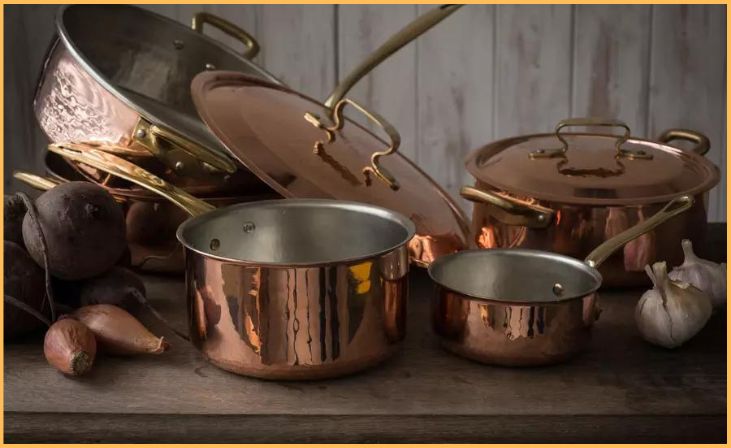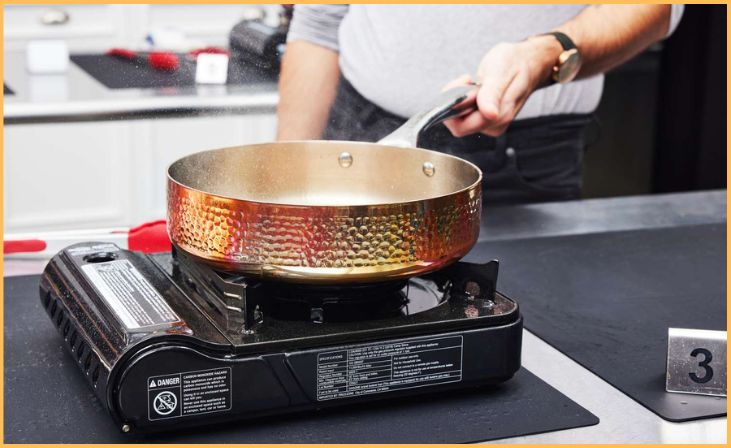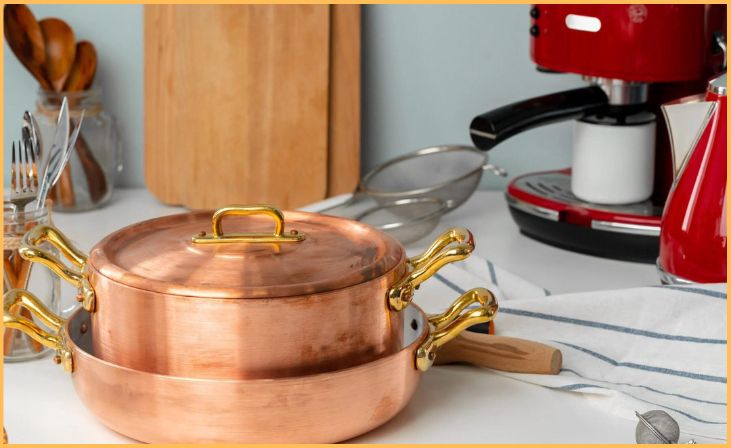Copper cookware stands out in the culinary realm due to its exceptional qualities, particularly its remarkable heat conductivity and distinctive traits. This article aims to explore seven essential facets crucial for any cooking enthusiast’s understanding of copper cookware. Whether you wield the tools of a professional chef or craft delicious meals at home, grasping these facets will undoubtedly elevate your experience with these exceptional copper kitchen companions.
Copper’s allure extends beyond its stunning appearance. Its ability to swiftly and evenly distribute heat is a hallmark feature. This trait allows for precise temperature control, a vital factor in achieving culinary perfection across various cooking techniques.
Must Try these Copper Cookware
1. Copper Cookware Heats Rapidly and Evenly

The exceptional heat conductivity of copper is a culinary treasure. When introduced to heat, copper swiftly and evenly spreads it across the entire cooking surface. This rapid and uniform distribution eradicates the formation of localized hot spots, guaranteeing an even temperature throughout the pan. This characteristic becomes an invaluable asset, ensuring consistent cooking results across every inch of the cookware’s surface. Whether searing, sautéing, or simmering, the absence of uneven heat areas allows for precise and uniform cooking, a crucial element in achieving culinary excellence.
Read also: Top Best Cuisinart Hammered Copper Cookware Sets for 2022
2. Excellent Heat Conduction for Precise Cooking
Copper cookware truly excels in handling delicate culinary tasks like preparing intricate sauces and mastering the art of sautéing. Its extraordinary heat conduction capability stands out in these scenarios, offering an unparalleled advantage. This remarkable trait enables precise temperature control, granting cooks the ability to maintain and adjust heat levels with finesse.
When crafting delicate sauces, the need for precise temperatures is paramount. Here, copper cookware’s proficiency shines brightly. The even distribution of heat throughout the pan ensures that every part of the sauce receives uniform warmth, preventing the risk of scorching or uneven cooking. Similarly, when sautéing ingredients that require careful attention to heat, copper’s conductivity facilitates a responsive cooking environment. This responsiveness empowers chefs to execute these culinary tasks flawlessly, achieving the desired textures and flavors in their creations.
3. Efficient Heat Distribution for Instant Adjustments

Copper’s rapid response to fluctuations in heat stands as a significant advantage for chefs in the culinary world. This responsiveness is akin to having a powerful tool at hand, allowing for immediate adjustments in cooking temperatures. This characteristic grants chefs an elevated level of control over the entire cooking process, which is invaluable, especially when precision is paramount.
Picture this: You’re in the midst of preparing a dish, and a swift alteration in heat is required. Copper cookware shines in these moments. Its ability to swiftly adapt to changes in temperature empowers chefs to make quick, precise adjustments, ensuring that the cooking process proceeds exactly as intended. This level of control over the heat source is a defining trait that sets copper cookware apart, making it a preferred choice among culinary professionals seeking perfection in their dishes.
4. Responsive to Temperature Changes for Culinary Mastery
The swift reaction of copper cookware to changes in temperature serves as a dynamic tool that empowers chefs in executing intricate recipes with finesse. Imagine navigating through a complex recipe that demands a range of cooking techniques – from searing to simmering or reducing. In these culinary maneuvers, the flexibility offered by copper cookware becomes indispensable.
Consider the precision required when searing ingredients to achieve that perfect caramelization or when delicately simmering a sauce to meld flavors harmoniously. Copper’s rapid response to temperature adjustments allows chefs to effortlessly transition between these cooking methods, ensuring each step is executed with the utmost precision.
Whether it’s the intense heat needed for searing or the gentle simmer required for reduction, copper cookware seamlessly accommodates these diverse cooking demands. Its ability to swiftly adapt to varying heat levels empowers chefs to maneuver through complex recipes, showcasing their culinary mastery without compromise.
5. Retains Heat Well for Braising and Slow Cooking

Copper’s exceptional heat retention capabilities make it an ideal choice for preparing slow-cooked dishes and braises. This unique quality allows the cookware to retain heat effectively, becoming an invaluable ally in the transformation of tough cuts of meat into succulent, tender delights.
Picture a slow-cooked stew or a braised dish—these culinary endeavors often involve tougher cuts of meat that require gentle, prolonged cooking to break down their fibers and render them tender. Here, the heat retention prowess of copper cookware plays a pivotal role. Once heated, copper retains this warmth remarkably well, creating an environment conducive to slow and steady cooking.
This ability to hold heat ensures a consistent and prolonged cooking temperature, crucial for slowly coaxing tough meat cuts to a state of delectable tenderness. The even distribution of heat throughout the cookware’s surface aids in the gradual breakdown of collagen in the meat, resulting in dishes that are not just cooked but transformed into flavorful, melt-in-your-mouth delights.
6. Copper Cookware Requires Regular Maintenance
While copper’s patina can be charming, frequent care is essential to maintain its shine. Tarnish is common, but regular cleaning using safe methods can restore its lustrous appearance.
7. Reacts with Certain Foods: The Acidic Factor

Copper’s interaction with acidic or alkaline foods is a significant consideration in the culinary realm. When exposed to such foods, copper has the potential to react, leading to the possibility of unwanted flavors seeping into the dish. To counteract this, many copper cookware items feature a protective lining of materials like stainless steel or tin.
Acidic foods, such as tomatoes or citrus fruits, can trigger a reaction with bare copper, imparting a metallic taste and potentially compromising the dish’s flavors. To mitigate this reactivity, cookware manufacturers often employ stainless steel or tin linings on the cooking surfaces. These linings act as a barrier, preventing direct contact between the food and the copper, thus averting any undesirable taste alterations.
This precautionary measure ensures that the excellent heat conductivity of copper remains unhindered while safeguarding the integrity of the dish’s flavors. By employing these protective linings, chefs and home cooks can harness the benefits of copper cookware without worrying about adverse reactions with certain types of foods.
8. Handle with Care: Prone to Scratches and Dents
Copper, despite its remarkable qualities, possesses a softness that renders it susceptible to scratches and dents. Preserving the integrity and aesthetic appeal of copper cookware necessitates a cautious approach in handling and cleaning.
The soft nature of copper means that it can easily incur scratches or dents, especially when exposed to rough handling or abrasive cleaning methods. Therefore, adopting a gentle approach in both usage and maintenance is crucial to safeguarding its appearance and functionality.
When handling copper cookware, care should be taken to avoid impacts or rough treatment that could result in dents or surface imperfections. Equally important is the cleaning process. Abrasive cleaning agents or harsh scouring pads can mar the surface of copper, compromising its lustrous finish. Opting for gentler cleaning tools and mild, non-abrasive cleaning agents is essential to maintain its pristine appearance.
Read Also: 4 Best Sizzling Plates: Sizzle Up Your Food!
9. Embracing the Beauty and Functionality of Copper

Embracing copper cookware requires a level of attentiveness, yet its allure and culinary benefits are unmistakable. Achieving mastery in the art of cooking with copper entails grasping its distinctive traits and harnessing them to enhance your culinary pursuits.
The undeniable aesthetic appeal of copper cookware adds a touch of elegance to any kitchen. Its lustrous appearance and the gradual development of a beautiful patina over time elevate the visual charm of the cooking space, making it a prized possession for chefs and home cooks alike.
However, beyond its visual appeal, understanding copper’s unique characteristics is pivotal. Recognizing its exceptional heat conductivity, swift responsiveness to temperature changes, and even its reactivity with certain foods lays the foundation for leveraging its advantages in the kitchen.
Conclusion
Copper cookware, with its unparalleled heat conductivity and unique features, is a cherished tool in the world of cooking. By comprehending its properties and practicing proper maintenance, you can elevate your culinary experiences to new heights.
In summary, delving into the world of copper cookware unveils a range of remarkable qualities and considerations. From its exceptional heat conductivity to its aesthetic allure, understanding the nuances of copper is essential for anyone passionate about the culinary arts. Embracing its strengths while being mindful of its reactivity and susceptibility to scratches, mastering the art of cooking with copper involves a blend of appreciation, knowledge, and finesse. By leveraging its unique characteristics, chefs and home cooks can transform their cooking experiences, creating culinary masterpieces that reflect both precision and artistry.
FAQs
Copper cookware lined with stainless steel or tin is safe for cooking. However, unlined copper might react with acidic or alkaline foods, posing health concerns.
Regularly polish your copper cookware using a gentle cleaner made specifically for copper. A protective coating can also help retain its shine.
Yes, copper cookware is versatile and works well on gas, electric, and induction stovetops.
Copper’s excellent heat conductivity and craftsmanship contribute to its higher cost compared to other materials used in cookware.
Yes, copper is soft and can be easily scratched or dented. Gentle handling and avoiding abrasive cleaning agents are crucial for preserving its integrity and appearance.







